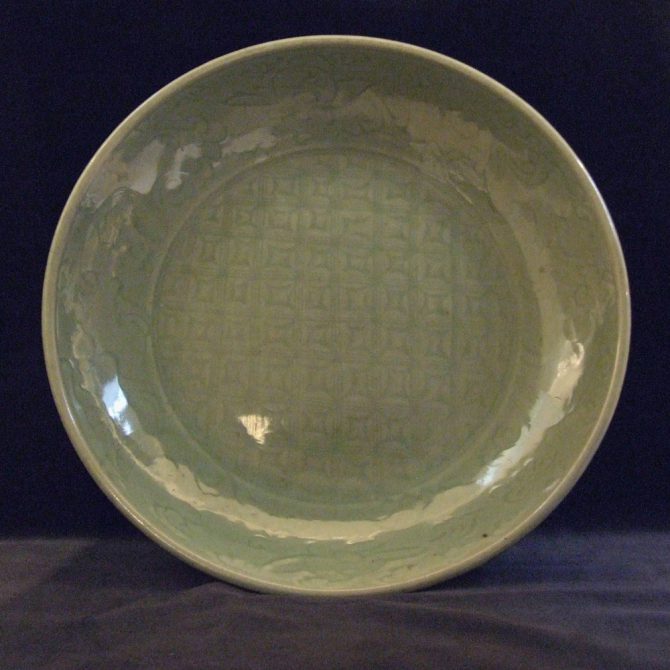
EARLY MING, HONGWU – XUANDE 1368 – 1435. Longquan Celadon Ware
An Early Ming Celadon Dish, Longquan Kilns, Zhejiang Province, Late 14th or Early 15th Century. Heavily Potted with Shallow, Rounded Sides, the Center of the Dish Carved with a Trellis Pattern. The Border of Vigorously Carved Scrolling Lotus. Glazed with a High Gloss Rich Olive-Green Celadon Glaze Front and Back Except a Firing-Ring on the Base Which is Left Unglazed, this has Fired Orange Due to Iron-Oxide in the Body.
SOLD
- Condition
- Perfect.
- Size
- Diameter : 36 cm (14 inches).
- Provenance
- S,Marchant & Son, label to base describing the piece as 16th century. A Private English Collection.
- Stock number
- 21083
Information
Celadon Ware.
Celadon is a term used to describe several types of Chinese stoneware and porcelain, as well a ceramics from other countries, notably from Korea and Japan. The term is a imprecise one, applying to various types of green glazed ceramics, but not all ceramics with green glazes, there are several wares that have a green glaze that are not refereed to as celadon. For example Green Jun and Ge Ware. For this reason there has been a move to try to clarify the situation by using the term `Green Ware`. But for now Celadon is a more familiar and therefore useful term. The origins of the term Celadon are not clear, one theory is that the term first appeared in France in the 17th century and that it is named after the shepherd Celadon in Honoré d`Urfé`s French pastoral romance, L`Astrée (1627), who wore pale green ribbons. (D`Urfe, in turn, borrowed his character from Ovid`s Metamorphoses.) Another theory is that the term is a corruption of the name of Saladin, the Ayyubid Sultan, who in 1171 sent forty pieces of the ceramic to Nur ad-Din, Sultan of Syria. Yet a third theory is that the word derives from the Sanskrit sila and dhara, which mean "stone" and "green" respectively.
Celadon ware originated in Zhejiang Province in the Eastern Han Dynasty, however green monochrome glazes can be found on stoneware much before that date. Zhejiang is were the famous Longquan Celadons were made but Celadon wares were also produced at Jiangsu, Hubei, Hunan and Jiangxi. The production of Celadon Ware required a reducing atmosphere of around 1300 degrees C., the colouring agent was a mixture of iron oxide and titanium. The glaze was applied very thickly, and was full of tiny bubbles which defuse the light giving the appearance of richness and softness.
For similar Early Ming Celadon Dish dishes of this type see : Chinese Ceramics in the Topkapi Saray Museum Istanbul, A Complete Catalogue, Volume 1, Yuan and Ming Dynasty Celadon Wares (Regina Krahl, Published in association with the Directorate of the Topkapi Saray Museum by Sotheby`s Publications 1986) page 329.
For similar but larger Early Ming Celadon Dish see : Gods of the Buddhist Pantheon & Fine Chinese Ceramics and Works of Art, Christie`s Hong Kong, 3rd November 1998, lot 915.

